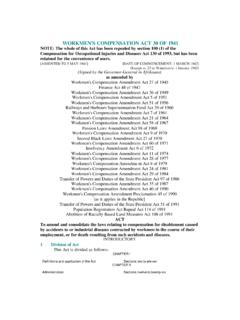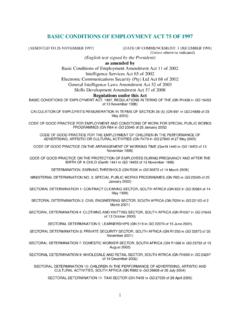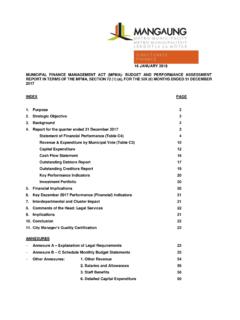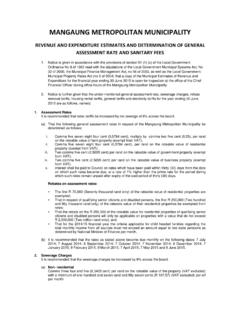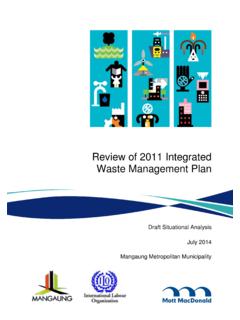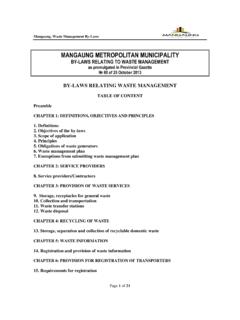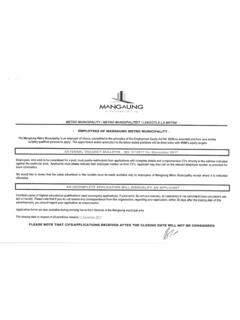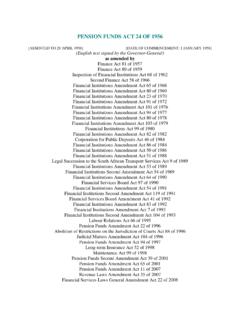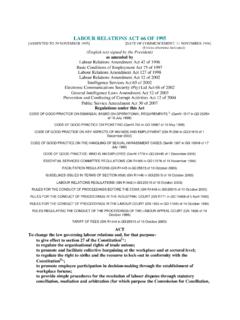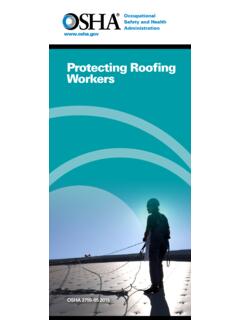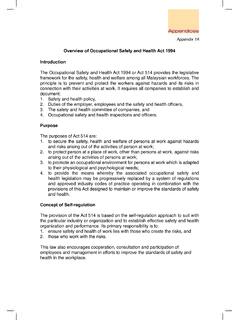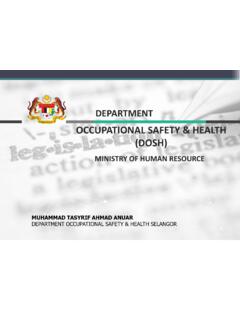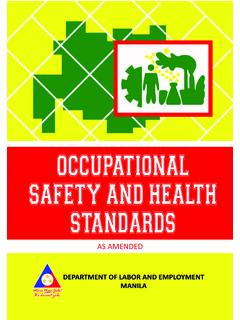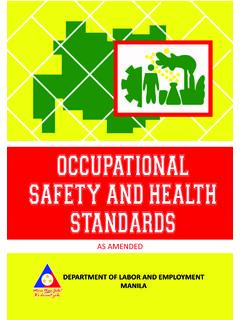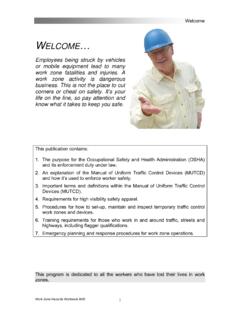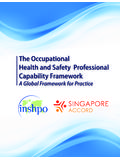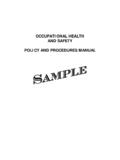Transcription of Occupational Health & Safety Act - AT THE HEART OF IT ALL
1 Occupational Health AND Safety ACT 85 OF 1993 [ASSENTED TO 23 JUNE 1993] [DATE OF COMMENCEMENT: 1 JANUARY 1994] (except s. 1 (3) (b): to be proclaimed) (English text signed by the State President) as amended by Occupational Health and Safety Amendment Act 181 of 1993 Labour Relations Act 66 of 1995 Regulations under this Act ASBESTOS REGULATIONS (GN R155 in GG 23108 of 10 February 2002) CERTIFICATE OF COMPETENCY, REGULATIONS CONCERNING THE (GN R533 in GG 12337 of 16 March 1990) CONSTRUCTION REGULATIONS (GN R1010 in GG 25207 of 18 July 2003) DIVING REGULATIONS (GN R10 in GG 22991 of 11 January 2002) DRIVEN MACHINERY REGULATIONS (GN R295 in GG 11152 of 26 February 1988) ELECTRICAL INSTALLATION REGULATIONS (GN R2920 in GG 14350 of 23 October 1992 i*) ELECTRICAL MACHINERY REGULATIONS (GN R1593 in GG 11458 of 12 August 1988)
2 ENVIRONMENTAL REGULATIONS FOR WORKPLACES (GN R2281 in GG 10988 of 16 October 1987) EXPLOSIVES REGULATIONS (GN R109 in GG 24272 of 17 January 2003) FACILITIES REGULATIONS (GN R924 in GG 26636 of 3 August 2004) GENERAL ADMINISTRATIVE REGULATIONS (GN R1449 in GG 17403 of 6 September 1996) GENERAL ADMINISTRATIVE REGULATIONS, 2003 (GN R929 in GG 25129 of 25 June 2003) GENERAL MACHINERY REGULATIONS (GN R1521 in GG 11443 of 5 August 1988) GENERAL Safety REGULATIONS (GN R1031 in GG 10252 of 30 May 1986) LEAD REGULATIONS (GN R236 in GG 23175 of 28 February 2002) LIFT, ESCALATOR AND PASSENGER CONVEYOR REGULATIONS (GN R797 in GG 15658 of 29 April 1994) MAJOR HAZARD INSTALLATION REGULATIONS ii* (GN R692 in GG 22506 of 30 July 2001) NOISE-INDUCED HEARING LOSS REGULATIONS (GN R307 in GG 24967 of 7 March 2003) REGULATIONS FOR HAZARDOUS BIOLOGICAL AGENTS (GN R1390 in GG 22956 of 27 December 2001) REGULATIONS FOR HAZARDOUS CHEMICAL SUBSTANCES (GN R1179 in GG 16596 of 25 August 1995) REGULATIONS FOR THE INTEGRATION OF THE Occupational Health AND Safety ACT, 1995iii* (GN R639 in GG 16387 of 28 April 1995) VESSELS UNDER PRESSURE REGULATIONS (GN R1591 in GG 17468 of 4 October 1996) ACT To provide for the Health and Safety of persons at work and for the Health and Safety of persons in connection with the use of plant and machinery.
3 The protection of 2 persons other than persons at work against hazards to Health and Safety arising out of or in connection with the activities of persons at work; to establish an advisory council for Occupational Health and Safety ; and to provide for matters connected therewith. 1 Definitions (1) In this Act, unless the context otherwise indicates- 'approved inspection authority' means an inspection authority approved by the chief inspector: Provided that an inspection authority approved by the chief inspector with respect to any particular service shall be an approved inspection authority with respect to that service only; 'biological monitoring' means a planned programme of periodic collection and analysis of body fluid, tissues, excreta or exhaled air in order to detect and quantify the exposure to or absorption of any substance or organism by persons; 'building' includes- (a) any structure attached to the soil.
4 (b) any building or such structure or part thereof which is in the process of being erected; or (c) any prefabricated building or structure not attached to the soil; 'chief executive officer', in relation to a body corporate or an enterprise conducted by the State, means the person who is responsible for the overall management and control of the business of such body corporate or enterprise; 'chief inspector' means the officer designated under section 27 as chief inspector, and includes any officer acting as chief inspector; 'Council' means the Advisory Council for Occupational Health and Safety established by section 2; 'danger' means anything which may cause injury or damage to persons or property; 'Department' means the Department of Manpower; 'employee' means, subject to the provisions of subsection (2), any person who is employed by or works for an employer and who receives or is entitled to receive any remuneration or who works under the direction or supervision of an employer or any other person; 'employer' means, subject to the provisions of subsection (2), any person who employs or provides work for any person and remunerates that person or expressly or tacitly undertakes to remunerate him, but excludes a labour broker as defined in section 1 (1) of the Labour Relations Act, 1956 (Act 28 of 1956).
5 'employers' organization' means an employers' organization as defined in section 1 of the Labour Relations Act, 1956 (Act 28 of 1956); [Definition of 'employers' organization' inserted by s. 1 (a) of Act 181 of 1993.] 'employment' or 'employed' means employment or employed as an employee; 'explosives' means any substance or article as listed in Class I: Explosives in the South African Bureau of Standards Code of Practice for the Identification and Classification of Dangerous Substances and Goods, SABS 0228; 'hazard' means a source of or exposure to danger; ' Health and Safety committee' means a committee established under section 19; ' Health and Safety equipment' means any article or part thereof which is 3 manufactured, provided or installed in the interest of the Health or Safety of any person; ' Health and Safety representative' means a person designated in terms of section 17 (1).
6 ' Health and Safety standard' means any standard, irrespective of whether or not it has the force of law, which, if applied for the purposes of this Act, will in the opinion of the Minister promote the attainment of an object of this Act; 'healthy' means free from illness or injury attributable to Occupational causes; 'incident' means an incident as contemplated in section 24 (1); 'industrial court' means the industrial court referred to in section 17 of the Labour Relations Act, 1956 (Act 28 of 1956); 'inspection authority' means any person who with the aid of specialized knowledge or equipment or after such investigations, tests, sampling or analyses as he may consider necessary, and whether for reward or otherwise, renders a service by making special findings, purporting to be objective findings, as to- (a) the Health of any person; (b) the Safety or risk to Health of any work, article, substance, plant or machinery, or of any condition prevalent on or in any premises.
7 Or (c) the question of whether any particular standard has been or is being complied with, with respect to any work, article, substance, plant or machinery, or with respect to work or a condition prevalent on or in any premises, or with respect to any other matter, and by issuing a certificate, stating such findings, to the person to whom the service is rendered; 'inspector' means a person designated under section 28; 'listed work' means any work declared to be listed work under section 11; 'local authority' means- (a) any institution or body contemplated in section 84 (1) (f) of the Provincial Government Act, 1961 (Act 32 of 1961); (b) any regional services council established under section 3 of the Regional Services Councils Act, 1985 (Act 109 of 1985); (c) any other institution or body or the holder of any office declared by the Minister by notice in the Gazette to be a local authority for the purposes of this Act; 'machinery' means any article or combination of articles assembled, arranged or connected and which is used or intended to be used for converting any form of energy to performing work, or which is used or intended to be used, whether incidental thereto or not, for developing, receiving, storing, containing, confining, transforming, transmitting, transferring or controlling any form of energy.
8 'major hazard installation' means an installation- (a) where more than the prescribed quantity of any substance is or may be kept, whether permanently or temporarily; or (b) where any substance is produced, processed, used, handled or stored in such a form and quantity that it has the potential to cause a major incident; 'major incident' means an occurrence of catastrophic proportions, resulting from the use of plant or machinery, or from activities at a workplace; 'mandatary' includes an agent, a contractor or a subcontractor for work, but 4 without derogating from his status in his own right as an employer or a user; 'medical surveillance' means a planned programme of periodic examination (which may include clinical examinations, biological monitoring or medical tests) of employees by an Occupational Health practitioner or, in prescribed cases, by an Occupational medicine practitioner; 'Minister' means the Minister of Manpower; ' Occupational Health ' includes Occupational hygiene, Occupational medicine and biological monitoring.
9 ' Occupational Health practitioner' means an Occupational medicine practitioner or a person who holds a qualification in Occupational Health recognized as such by the South African Medical and Dental Council as referred to in the Medical, Dental and Supplementary Health Service Professions Act, 1974 (Act 56 of 1974), or the South African Nursing Council as referred to in the Nursing Act, 1978 (Act 50 of 1978); ' Occupational hygiene' means the anticipation, recognition, evaluation and control of conditions arising in or from the workplace, which may cause illness or adverse Health effects to persons; ' Occupational medicine' means the prevention, diagnosis and treatment of illness, injury and adverse Health effects associated with a particular type of work; ' Occupational medicine practitioner' means a medical practitioner as defined in the Medical, Dental and Supplementary Health Service Professions Act, 1974 (Act 56 of 1974), who holds a qualification in Occupational medicine or an equivalent qualification which qualification or equivalent is recognized as such by the South African Medical and Dental Council referred to in the said Act; 'office' means an office as defined in section 1 (1) of the Basic Conditions of Employment Act, 1983 (Act 3 of 1983)iv*.
10 'officer' means an officer or employee as defined in section 1 (1) of the Public Service Act, 1984 (Act 111 of 1984); 'organism' means any biological entity which is capable of causing illness to persons; 'plant' includes fixtures, fittings, implements, equipment, tools and appliances, and anything which is used for any purpose in connection with such plant; 'premises' includes any building, vehicle, vessel, train or aircraft; 'prescribed' means prescribed by regulation; 'properly used' means used with reasonable care, and with due regard to any information, instruction or advice supplied by the designer, manufacturer, importer, seller or supplier; 'reasonably practicable' means practicable having regard to- (a) the severity and scope of the hazard or risk concerned; (b) the state of knowledge reasonably available concerning that hazard or risk and of any means of removing or mitigating that hazard or risk; (c) the availability and suitability of means to remove or mitigate that hazard or risk; and (d) the cost of removing or mitigating that hazard or risk in relation to the benefits deriving therefrom; 'regulation' means a regulation made under
